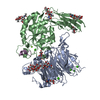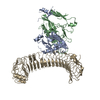+ Open data
Open data
- Basic information
Basic information
| Entry | Database: PDB / ID: 8vsd | ||||||
|---|---|---|---|---|---|---|---|
| Title | avb8/L-TGF-b1/GARP | ||||||
 Components Components |
| ||||||
 Keywords Keywords | SIGNALING PROTEIN / Integrin / Complex | ||||||
| Function / homology |  Function and homology information Function and homology informationestablishment of protein localization to extracellular region / ganglioside metabolic process / Langerhans cell differentiation / secondary palate development / integrin alphav-beta8 complex / integrin alphav-beta6 complex / transforming growth factor beta production / negative regulation of entry of bacterium into host cell / integrin alphav-beta5 complex / opsonin binding ...establishment of protein localization to extracellular region / ganglioside metabolic process / Langerhans cell differentiation / secondary palate development / integrin alphav-beta8 complex / integrin alphav-beta6 complex / transforming growth factor beta production / negative regulation of entry of bacterium into host cell / integrin alphav-beta5 complex / opsonin binding / integrin alphav-beta1 complex / Cross-presentation of particulate exogenous antigens (phagosomes) / extracellular matrix protein binding / placenta blood vessel development / Laminin interactions / receptor ligand inhibitor activity / integrin alphav-beta3 complex / negative regulation of lipoprotein metabolic process / entry into host cell by a symbiont-containing vacuole / alphav-beta3 integrin-PKCalpha complex / alphav-beta3 integrin-HMGB1 complex / negative regulation of lipid transport / hard palate development / regulation of phagocytosis / Elastic fibre formation / alphav-beta3 integrin-IGF-1-IGF1R complex / transforming growth factor beta binding / positive regulation of small GTPase mediated signal transduction / cartilage development / filopodium membrane / extracellular matrix binding / negative regulation of low-density lipoprotein particle clearance / apolipoprotein A-I-mediated signaling pathway / apoptotic cell clearance / wound healing, spreading of epidermal cells / integrin complex / heterotypic cell-cell adhesion / Molecules associated with elastic fibres / negative regulation of cytokine production / negative chemotaxis / Mechanical load activates signaling by PIEZO1 and integrins in osteocytes / cell adhesion mediated by integrin / Syndecan interactions / positive regulation of osteoblast proliferation / microvillus membrane / cell-substrate adhesion / negative regulation of activated T cell proliferation / endodermal cell differentiation / PECAM1 interactions / TGF-beta receptor signaling activates SMADs / positive regulation of intracellular signal transduction / fibronectin binding / lamellipodium membrane / negative regulation of macrophage derived foam cell differentiation / negative regulation of lipid storage / ECM proteoglycans / Integrin cell surface interactions / vasculogenesis / specific granule membrane / voltage-gated calcium channel activity / coreceptor activity / phagocytic vesicle / ERK1 and ERK2 cascade / extrinsic apoptotic signaling pathway in absence of ligand / extracellular matrix / positive regulation of cell adhesion / substrate adhesion-dependent cell spreading / transforming growth factor beta receptor signaling pathway / protein kinase C binding / Turbulent (oscillatory, disturbed) flow shear stress activates signaling by PIEZO1 and integrins in endothelial cells / cell-matrix adhesion / Signal transduction by L1 / integrin-mediated signaling pathway / negative regulation of extrinsic apoptotic signaling pathway / negative regulation of transforming growth factor beta receptor signaling pathway / cell-cell adhesion / calcium ion transmembrane transport / VEGFA-VEGFR2 Pathway / response to virus / ruffle membrane / integrin binding / positive regulation of angiogenesis / cell migration / positive regulation of cytosolic calcium ion concentration / virus receptor activity / protease binding / angiogenesis / cell adhesion / immune response / positive regulation of cell migration / negative regulation of gene expression / external side of plasma membrane / focal adhesion / positive regulation of cell population proliferation / Neutrophil degranulation / positive regulation of gene expression / symbiont entry into host cell / cell surface / extracellular space / extracellular exosome Similarity search - Function | ||||||
| Biological species |  Homo sapiens (human) Homo sapiens (human) | ||||||
| Method | ELECTRON MICROSCOPY / single particle reconstruction / cryo EM / Resolution: 3.2 Å | ||||||
 Authors Authors | Jin, M. / Cheng, Y. / Nishimura, S.L. | ||||||
| Funding support |  United States, 1items United States, 1items
| ||||||
 Citation Citation |  Journal: Cell / Year: 2024 Journal: Cell / Year: 2024Title: Dynamic allostery drives autocrine and paracrine TGF-β signaling. Authors: Mingliang Jin / Robert I Seed / Guoqing Cai / Tiffany Shing / Li Wang / Saburo Ito / Anthony Cormier / Stephanie A Wankowicz / Jillian M Jespersen / Jody L Baron / Nicholas D Carey / Melody ...Authors: Mingliang Jin / Robert I Seed / Guoqing Cai / Tiffany Shing / Li Wang / Saburo Ito / Anthony Cormier / Stephanie A Wankowicz / Jillian M Jespersen / Jody L Baron / Nicholas D Carey / Melody G Campbell / Zanlin Yu / Phu K Tang / Pilar Cossio / Weihua Wen / Jianlong Lou / James Marks / Stephen L Nishimura / Yifan Cheng /  Abstract: TGF-β, essential for development and immunity, is expressed as a latent complex (L-TGF-β) non-covalently associated with its prodomain and presented on immune cell surfaces by covalent association ...TGF-β, essential for development and immunity, is expressed as a latent complex (L-TGF-β) non-covalently associated with its prodomain and presented on immune cell surfaces by covalent association with GARP. Binding to integrin αvβ8 activates L-TGF-β1/GARP. The dogma is that mature TGF-β must physically dissociate from L-TGF-β1 for signaling to occur. Our previous studies discovered that αvβ8-mediated TGF-β autocrine signaling can occur without TGF-β1 release from its latent form. Here, we show that mice engineered to express TGF-β1 that cannot release from L-TGF-β1 survive without early lethal tissue inflammation, unlike those with TGF-β1 deficiency. Combining cryogenic electron microscopy with cell-based assays, we reveal a dynamic allosteric mechanism of autocrine TGF-β1 signaling without release where αvβ8 binding redistributes the intrinsic flexibility of L-TGF-β1 to expose TGF-β1 to its receptors. Dynamic allostery explains the TGF-β3 latency/activation mechanism and why TGF-β3 functions distinctly from TGF-β1, suggesting that it broadly applies to other flexible cell surface receptor/ligand systems. | ||||||
| History |
|
- Structure visualization
Structure visualization
| Structure viewer | Molecule:  Molmil Molmil Jmol/JSmol Jmol/JSmol |
|---|
- Downloads & links
Downloads & links
- Download
Download
| PDBx/mmCIF format |  8vsd.cif.gz 8vsd.cif.gz | 380.3 KB | Display |  PDBx/mmCIF format PDBx/mmCIF format |
|---|---|---|---|---|
| PDB format |  pdb8vsd.ent.gz pdb8vsd.ent.gz | 300 KB | Display |  PDB format PDB format |
| PDBx/mmJSON format |  8vsd.json.gz 8vsd.json.gz | Tree view |  PDBx/mmJSON format PDBx/mmJSON format | |
| Others |  Other downloads Other downloads |
-Validation report
| Summary document |  8vsd_validation.pdf.gz 8vsd_validation.pdf.gz | 1.2 MB | Display |  wwPDB validaton report wwPDB validaton report |
|---|---|---|---|---|
| Full document |  8vsd_full_validation.pdf.gz 8vsd_full_validation.pdf.gz | 1.3 MB | Display | |
| Data in XML |  8vsd_validation.xml.gz 8vsd_validation.xml.gz | 60.5 KB | Display | |
| Data in CIF |  8vsd_validation.cif.gz 8vsd_validation.cif.gz | 91.5 KB | Display | |
| Arichive directory |  https://data.pdbj.org/pub/pdb/validation_reports/vs/8vsd https://data.pdbj.org/pub/pdb/validation_reports/vs/8vsd ftp://data.pdbj.org/pub/pdb/validation_reports/vs/8vsd ftp://data.pdbj.org/pub/pdb/validation_reports/vs/8vsd | HTTPS FTP |
-Related structure data
| Related structure data |  43494MC  8vs6C  8vsbC  8vscC C: citing same article ( M: map data used to model this data |
|---|---|
| Similar structure data | Similarity search - Function & homology  F&H Search F&H Search |
- Links
Links
- Assembly
Assembly
| Deposited unit | 
|
|---|---|
| 1 |
|
- Components
Components
-Transforming growth factor ... , 2 types, 3 molecules IEF
| #1: Protein | Mass: 61344.055 Da / Num. of mol.: 1 Source method: isolated from a genetically manipulated source Source: (gene. exp.)  Homo sapiens (human) / Gene: LRRC32, D11S833E / Production host: Homo sapiens (human) / Gene: LRRC32, D11S833E / Production host:  Homo sapiens (human) / References: UniProt: Q14392 Homo sapiens (human) / References: UniProt: Q14392 |
|---|---|
| #4: Protein | Mass: 41323.219 Da / Num. of mol.: 2 Source method: isolated from a genetically manipulated source Source: (gene. exp.)  Homo sapiens (human) / Gene: TGFB1, TGFB / Production host: Homo sapiens (human) / Gene: TGFB1, TGFB / Production host:  Homo sapiens (human) Homo sapiens (human) |
-Protein , 2 types, 2 molecules AB
| #2: Protein | Mass: 65268.188 Da / Num. of mol.: 1 Source method: isolated from a genetically manipulated source Source: (gene. exp.)  Homo sapiens (human) / Gene: ITGAV, MSK8, VNRA, VTNR / Production host: Homo sapiens (human) / Gene: ITGAV, MSK8, VNRA, VTNR / Production host:  |
|---|---|
| #3: Protein | Mass: 39574.234 Da / Num. of mol.: 1 Source method: isolated from a genetically manipulated source Source: (gene. exp.)  Homo sapiens (human) / Gene: ITGB8 / Production host: Homo sapiens (human) / Gene: ITGB8 / Production host:  |
-Sugars , 3 types, 8 molecules 
| #5: Polysaccharide | alpha-D-mannopyranose-(1-2)-alpha-D-mannopyranose-(1-3)-[alpha-D-mannopyranose-(1-6)]beta-D- ...alpha-D-mannopyranose-(1-2)-alpha-D-mannopyranose-(1-3)-[alpha-D-mannopyranose-(1-6)]beta-D-mannopyranose-(1-4)-2-acetamido-2-deoxy-beta-D-glucopyranose-(1-4)-2-acetamido-2-deoxy-beta-D-glucopyranose Source method: isolated from a genetically manipulated source | ||
|---|---|---|---|
| #6: Polysaccharide | 2-acetamido-2-deoxy-beta-D-glucopyranose-(1-4)-2-acetamido-2-deoxy-beta-D-glucopyranose Source method: isolated from a genetically manipulated source #7: Sugar | |
-Non-polymers , 2 types, 6 molecules 


| #8: Chemical | ChemComp-CA / #9: Chemical | ChemComp-MG / | |
|---|
-Details
| Has ligand of interest | N |
|---|---|
| Has protein modification | Y |
-Experimental details
-Experiment
| Experiment | Method: ELECTRON MICROSCOPY |
|---|---|
| EM experiment | Aggregation state: PARTICLE / 3D reconstruction method: single particle reconstruction |
- Sample preparation
Sample preparation
| Component |
| ||||||||||||||||||||||||||||
|---|---|---|---|---|---|---|---|---|---|---|---|---|---|---|---|---|---|---|---|---|---|---|---|---|---|---|---|---|---|
| Molecular weight |
| ||||||||||||||||||||||||||||
| Source (natural) |
| ||||||||||||||||||||||||||||
| Source (recombinant) |
| ||||||||||||||||||||||||||||
| Buffer solution | pH: 7.4 | ||||||||||||||||||||||||||||
| Specimen | Embedding applied: NO / Shadowing applied: NO / Staining applied: NO / Vitrification applied: YES | ||||||||||||||||||||||||||||
| Vitrification | Cryogen name: ETHANE |
- Electron microscopy imaging
Electron microscopy imaging
| Experimental equipment |  Model: Titan Krios / Image courtesy: FEI Company |
|---|---|
| Microscopy | Model: FEI TITAN KRIOS |
| Electron gun | Electron source:  FIELD EMISSION GUN / Accelerating voltage: 300 kV / Illumination mode: FLOOD BEAM FIELD EMISSION GUN / Accelerating voltage: 300 kV / Illumination mode: FLOOD BEAM |
| Electron lens | Mode: BRIGHT FIELD / Nominal defocus max: 2500 nm / Nominal defocus min: 800 nm |
| Image recording | Electron dose: 68 e/Å2 / Film or detector model: GATAN K3 (6k x 4k) |
- Processing
Processing
| CTF correction | Type: PHASE FLIPPING AND AMPLITUDE CORRECTION |
|---|---|
| 3D reconstruction | Resolution: 3.2 Å / Resolution method: FSC 0.143 CUT-OFF / Num. of particles: 46771 / Symmetry type: POINT |
| Refinement | Highest resolution: 3.2 Å |
 Movie
Movie Controller
Controller









 PDBj
PDBj

















